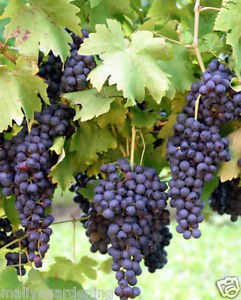The facility consists of 23 acres of Concord grapes, 5 acres of Niagara grapes, and the rest of the land is used for several varieties of wine and table grapes.
Background Information
The grape-processing industry has a large presence along the coastline of Lake Erie in both Pennsylvania and New York. The lake moderates the climate in this area, allowing for grapes to grow. The Lake Erie Regional Grape Research and Extension Center(LERGREC) sits right along the coastline of Lake Erie in North East, Pennsylvania and serves the grape growing industry in a number of ways. Research at the station is dividied into the fields of entomology and plant pathology. This station is also part of a cooperative effort between Penn State and Cornell University(located in Portland, New York) for organizing extension education programs and field days.
The Grape Industry in Pennsylvania
- The Lake Erie Grape Belt is the second largest grape growing region in the US.
- This region extends about 50 miles from Chautauqua County in New York, to Erie County in Pennsylvania.
- The annual income for the 250 commercial vineyards in Pennsylvania is about $15 million.
- Erie County account for 72% of grape production in Pennsylvania.
- 12% of Erie's total grape production accounts for wine grapes.
- Pennsylvania has a total of roughly 250 wineries throughout the state.
- In Pennsylvania, the wine-making industry, which is the fastest growing segment of the grape industry, has an estimated income of about $200 million.
Grapes at LERGREC
The LERGREC facility consists of 40 acres of land on which several varieties of grapes are grown. 23 acres of this land are reserved for Concords, 5 acres for Niagaras, and the rest are used for several varieties of wine and table grapes. The Concord and Niagara grapes grown at the station are sold to Welch's, and the wine grapes are sold to local wineries in the North East region. The wine grape varieties grown at the station include Chancellor, Chambourcin, Vignoles, Gruner, Riesling and Vidal. The table grapes grown at the station are new and just beginning to produce as of 2018. A few test-vines are also grown in order to monitor and research how they endure the winters of Erie.
Plant Pathology and Entomology Research
Grape disease management is a crucial factor in any vineyard. Bryan Hed is the head of plant pathology research done at LERGREC. His research consists of exploring, testing, developing and integrating low-impact means of controlling grape diseases. Some common diseases that Brian studies include black rot, powdery mildew, downy mildew, bunch rot and cane and leaf spot.
Management of pests in vineyards is also important for the health and viability of grape vines. Jody Timer is the head of entomology research at LERGREC. Her research focuses on biocontrol of primary vineyard insect pests, as well as conducting efficacy trials with new insecticides. A few common insects found in Lake Erie vineyards include grape berry moth, leafhoppers, rose chafer and grape rootworm. A few invasive species that Jody also studies are spotted wing drosophila, Japanese beetle, brown marmorated stink bug and multicolored Asian lady beetle.


